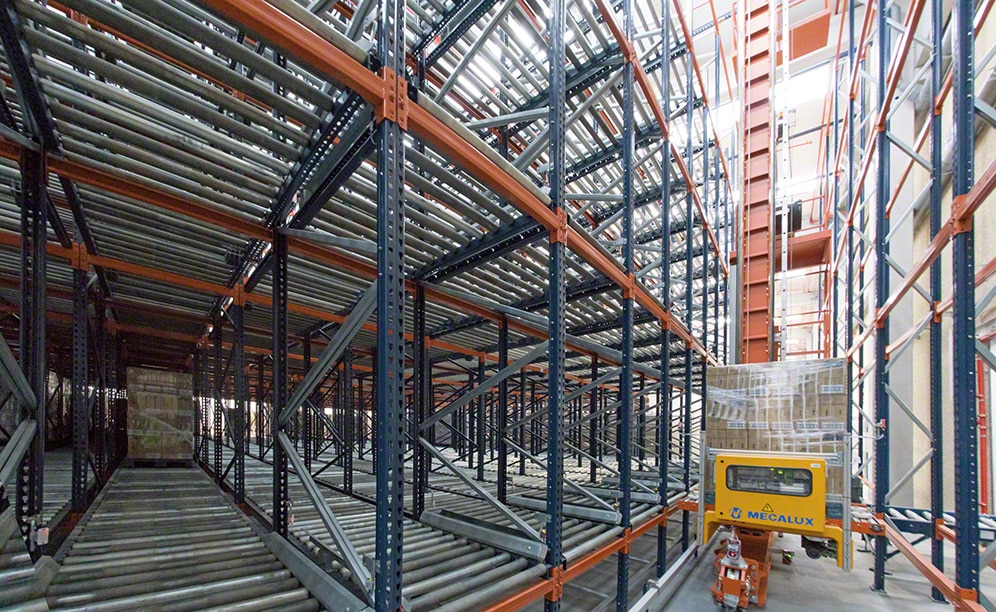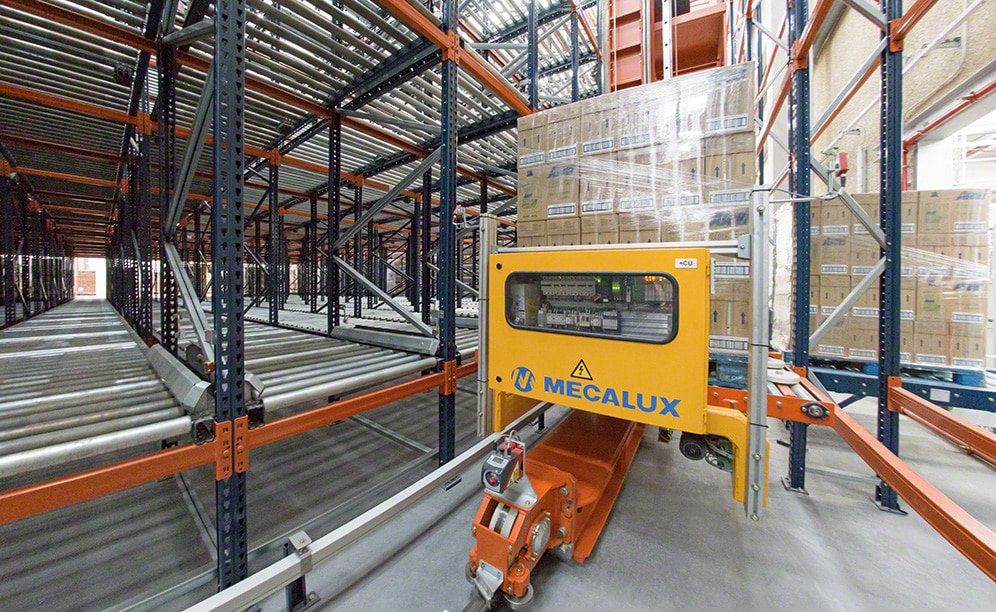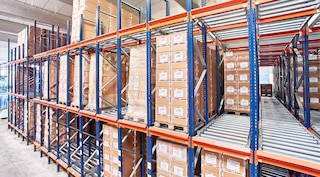
Two storage systems for chemical cleaning products
Live racking with stacker cranes and the semi-automatic Pallet Shuttle system in the Pons Químicas warehouse
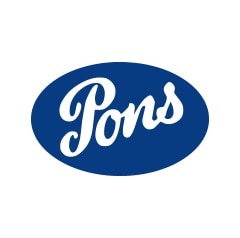
Pons Químicas, the cleaning supplies maker, has reorganised the operations of its warehouse in Jávea (Alicante) under the guidance of Mecalux. On one side, it has installed a block of live pallet racking operated by a stacker crane where it stores finished products. On the other, the semi-automatic Pallet Shuttle, that supplies the production centre with needed packaging. Additionally, Mecalux has enabled conveyors that join the production exit to the warehouse and deployed the Easy WMS warehouse management software.
Needs of Pons Químicas
Pons Químicas is a Spanish company that was founded in 1960 and specialises in household and professional grade cleaning products. Spain is the site of one production plant, while another is set up in Romania.
Over the last few years, it has pushed its market boundaries throughout Europe and Africa. To do so, it required higher storage capacity, while also increasing the productivity of its warehouse located next to its manufacturing centre in the town of Jávea (Alicante). Pons Químicas has always relied on the collaboration and expertise of Mecalux to work out a solution that would be a perfect fit for their demands.
Production warehouse
With Pons Químicas needs in mind, Mecalux has set up:
- Live pallet racking run by a stacker crane.
- Semi-automatic Pallet Shuttle system.
- Roller conveyors.
The installation of these systems was executed in several phases, taking into account the company’s needs and the increase in production achieved over the last few years.
Live pallet racking run by the stacker crane is allocated to finished products. This automated warehouse can operate 24 hours a day, uninterrupted and with minimal personnel. Moreover, it ensures permanent workflows.
Meanwhile, the semi-automatic Pallet Shuttle system acts as a buffer, i.e., as a temporary warehouse where bottles used for everyday production processes are housed.
Both storage systems are compact systems, and make full use of the available surface to obtain optimal capacity.
Pallet Shuttle system
The block of racks is 11.3 m high and comprises 31 channels that provide a 600-pallet storage capacity. The merchandise flowing from the production centre is slotted through the loading aisle (next to the docks) and later taken out of the opposite side, for unloading, that coincides with production.
It is a highly systematic way to supply the production centre with the required packaging, since the whole process is quick and straightforward. Operators do not drive the forklifts into the lanes to handle the goods. Instead, the shuttle carries out all movements automatically.
Operators, riding reach trucks, place the Pallet Shuttles in a specified channel. Next, they transfer the pallets to the first position in the racks and the motorised shuttle shoots them straight up to the first free location The same operation is done but in reverse order to extract the goods through the unloading aisle.
Automated warehouse
A roller conveyor circuit shifts the goods from the production centre up to the warehouse automatically.
This system requires minimal involvement on the part of workers, thus, eliminating errors that result from manual handling.
Afterward, the stacker crane picks the pallets off the incoming conveyor and deposits them in the allocated channel. This machine operates at speeds of 160 m/min and 38 m/min when raised, being able to absorb a huge number of deliveries flowing from production and to insert them into the live racking.
The block of racks stands 10.2 m high and 45 m long. Comprised of 160 channels, each 22.5 m deep channel can house up to 18 pallets. Overall, the automated warehouse offers a 2,880-pallet storage capacity for 800 x 1,200 mm bases. Racks comprise slightly inclined roller channels so that the merchandise flows via gravity.
The stacker crane puts the pallets into the highest part of the roller frames. Gravity does the rest, and at a controlled speed, moving them towards the other end ready to be removed.
This solution speeds up the loading and unloading of pallets, since handling by personnel is very low (they only pick pallets from their specific locations). Plus, the distances being covered are nominal, since all SKUs are in the same aisle.
The goods are managed according to the FIFO storage method (first in, first out). In other words, the first pallet in is the first to leave, making precise product rotation possible.
Easy WMS by Mecalux
The warehouse management software developed by Mecalux controls the flows of the automated warehouse. It steps in during different operations and processes, from the entry of pallets on the conveyors, the assigning of specific locations, up to their subsequent extraction to send to dispatch. Likewise, it controls the stock and always knows where the merchandise is located and its status.
The Easy WMS by Mecalux is in continuous, bi-directional communication with Pons Químicas’ ERP.
Furthermore, it has rolled out the Galileo control module that directs the electromechanical equipment movements, such as the conveyors and stacker cranes.
Advantages for Pons Químicas
- Boosted storage capacity: a total of 3,480 pallets can be housed in the Pons Químicas warehouse.
- Agility and density: the two storage systems facilitate the loading and unloading of the products in short order.
- Efficient management: warehouse operations are directed and organised using the Mecalux Easy WMS.
| Live racking | |
|---|---|
| Storage capacity: | 2,880 pallets |
| Pallet sizes: | 800 x 1,200 x 1,500 / 1,800 mm |
| Max. pallet weight: | 750 kg |
| Levels high: | 4 |
| No. of channels: | 160 |
| Racking height: | 10.2 m |
Gallery
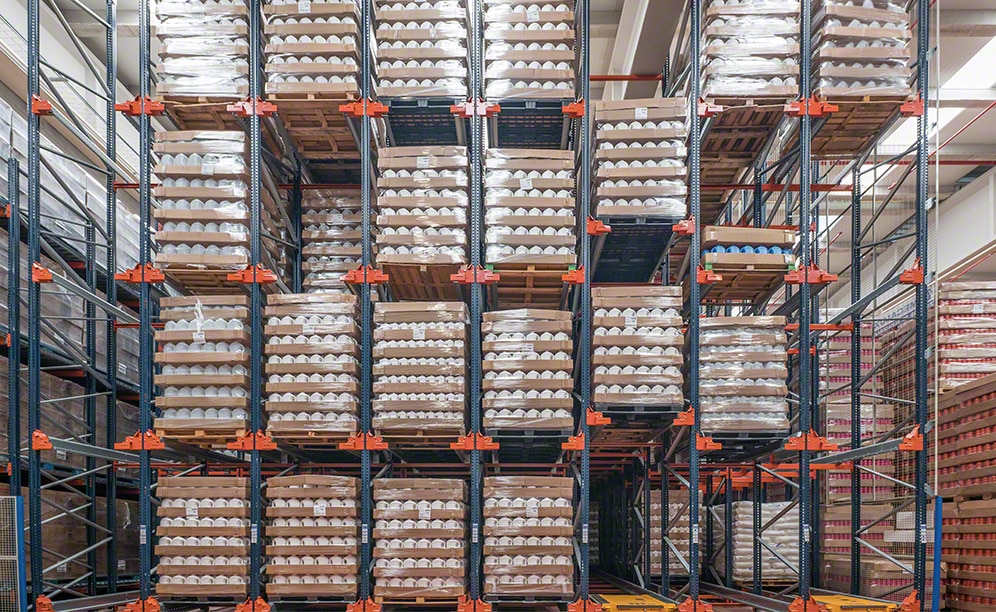
Installation focuses on the storage of Pons Químicas warehouse
Ask an expert

